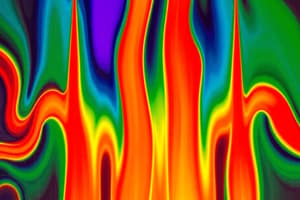Podcast
Questions and Answers
What is the term for the heat required to change 1.0 kg of a substance from solid to liquid?
What is the term for the heat required to change 1.0 kg of a substance from solid to liquid?
- Condensation heat
- Latent heat of fusion (correct)
- Evaporation heat
- Sublimation heat
The total heat required for a phase change is independent of the mass of the substance.
The total heat required for a phase change is independent of the mass of the substance.
False (B)
What is the primary factor that changes during evaporation at temperatures below boiling point?
What is the primary factor that changes during evaporation at temperatures below boiling point?
The potential energy of the molecules
The heat required to vaporize 1.0 kg of a substance from liquid to gas is known as __________.
The heat required to vaporize 1.0 kg of a substance from liquid to gas is known as __________.
Match the following terms with their definitions:
Match the following terms with their definitions:
What is the unit of heat defined as the amount needed to raise the temperature of 1 g of water by 1 °C?
What is the unit of heat defined as the amount needed to raise the temperature of 1 g of water by 1 °C?
The internal energy of a system is the sum of all kinetic and potential energies of its molecules.
The internal energy of a system is the sum of all kinetic and potential energies of its molecules.
What is the relationship between temperature and the kinetic energy of molecules?
What is the relationship between temperature and the kinetic energy of molecules?
In an ______ system, neither mass nor energy can be exchanged with the surroundings.
In an ______ system, neither mass nor energy can be exchanged with the surroundings.
Match the following terms with their correct definitions:
Match the following terms with their correct definitions:
Which of the following statements about an open system is true?
Which of the following statements about an open system is true?
1 cal is equivalent to 4.186 kJ.
1 cal is equivalent to 4.186 kJ.
What happens to the water temperature when it is transferred to a cooler object?
What happens to the water temperature when it is transferred to a cooler object?
In an isothermal process, which equation represents the pressure of an ideal gas?
In an isothermal process, which equation represents the pressure of an ideal gas?
In an adiabatic process, heat is exchanged with the surroundings.
In an adiabatic process, heat is exchanged with the surroundings.
What happens to the internal energy in an isothermal process?
What happens to the internal energy in an isothermal process?
In an isovolumetric process, the___ remains constant.
In an isovolumetric process, the___ remains constant.
Match the following processes with their characteristics:
Match the following processes with their characteristics:
Which of the following statements is correct regarding work done on a gas?
Which of the following statements is correct regarding work done on a gas?
In an isobare process, the pressure of the gas changes.
In an isobare process, the pressure of the gas changes.
In an ideal gas undergoing isothermal expansion, how does the work done relate to the heat absorbed?
In an ideal gas undergoing isothermal expansion, how does the work done relate to the heat absorbed?
What is true for an isobaric process?
What is true for an isobaric process?
In an isovolumetric process, the work done is zero.
In an isovolumetric process, the work done is zero.
What does the equipartition theorem state?
What does the equipartition theorem state?
In conductive heat transfer, the constant k is known as the __________.
In conductive heat transfer, the constant k is known as the __________.
Match the types of heat transfer with their definitions:
Match the types of heat transfer with their definitions:
In the ideal gas state, which law relates pressure, volume, and temperature upon differentiation?
In the ideal gas state, which law relates pressure, volume, and temperature upon differentiation?
Materials with high thermal conductivity are known as insulators.
Materials with high thermal conductivity are known as insulators.
What is the definition of an adiabatic process?
What is the definition of an adiabatic process?
Flashcards
What is heat?
What is heat?
The transfer of energy from one object to another due to a difference in temperature.
What is temperature?
What is temperature?
The measure of the kinetic energy of molecules within a substance.
What is internal energy?
What is internal energy?
The total energy of all the molecules within an object.
What is specific heat?
What is specific heat?
Signup and view all the flashcards
Describe a closed system?
Describe a closed system?
Signup and view all the flashcards
Describe an open system?
Describe an open system?
Signup and view all the flashcards
Describe an isolated system?
Describe an isolated system?
Signup and view all the flashcards
What is the first law of thermodynamics?
What is the first law of thermodynamics?
Signup and view all the flashcards
Latent heat
Latent heat
Signup and view all the flashcards
Heat of fusion (LF)
Heat of fusion (LF)
Signup and view all the flashcards
Heat of vaporization (LV)
Heat of vaporization (LV)
Signup and view all the flashcards
First law of thermodynamics
First law of thermodynamics
Signup and view all the flashcards
Internal energy
Internal energy
Signup and view all the flashcards
Molar specific heat at constant volume (Cv)
Molar specific heat at constant volume (Cv)
Signup and view all the flashcards
Molar specific heat at constant pressure (Cp)
Molar specific heat at constant pressure (Cp)
Signup and view all the flashcards
Adiabatic index (gamma)
Adiabatic index (gamma)
Signup and view all the flashcards
Adiabatic process
Adiabatic process
Signup and view all the flashcards
Isovolumetric process
Isovolumetric process
Signup and view all the flashcards
Isobaric process
Isobaric process
Signup and view all the flashcards
Equipartition theorem
Equipartition theorem
Signup and view all the flashcards
Degrees of freedom
Degrees of freedom
Signup and view all the flashcards
Work in infinitesimal volume change
Work in infinitesimal volume change
Signup and view all the flashcards
Isothermal Process: Work and Heat
Isothermal Process: Work and Heat
Signup and view all the flashcards
Isobaric Process: Work
Isobaric Process: Work
Signup and view all the flashcards
Isovolumetric Process: Work
Isovolumetric Process: Work
Signup and view all the flashcards
Work: Path Dependence
Work: Path Dependence
Signup and view all the flashcards
Molar Specific Heat Capacity in Gases
Molar Specific Heat Capacity in Gases
Signup and view all the flashcards
Equipartition of Energy
Equipartition of Energy
Signup and view all the flashcards
Study Notes
Chapter 19: Heat and the First Law of Thermodynamics
- Heat as Energy Transfer: Heat is a form of energy that flows from one object to another due to a temperature difference. The unit of heat is the calorie (cal), where 1 cal is the amount of heat needed to raise the temperature of 1 gram of water by 1°C. 4.186 J equals 1 cal and 4.186 kJ equals 1 kcal.
Heat as Energy Transfer - Definitions
-
Definition of Heat: Heat is energy transferred from one object to another because of a difference in temperature.
-
Temperature: A measure of the average kinetic energy of the molecules in an object. An increase in temperature signifies increased molecular kinetic energy. The relationship between these is: kT = (1/3) K, where k is Boltzmann's constant
-
Internal Energy: The sum of all energy of the molecules in an object, encompassing kinetic and potential energy. Internal energy is related to temperature; higher temperature leads to higher internal energy.
Internal Energy
-
Monatomic Ideal Gas: For a monatomic (single-atom) ideal gas, internal energy is given as Eint = (3/2)NkT, where N is the number of molecules, k is Boltzmann's constant, and T is the temperature.
-
Gas Molecules with Multiple Atoms: Gas molecules with multiple atoms additionally possess rotational and vibrational energy, increasing their internal energy compared to monatomic gases.
Specific Heat
-
Specific Heat (c): The amount of heat required to raise the temperature of 1 kg of a substance by 1°C. The value of 'c' depends on the material. Q = mc∆T. This is a constant of proportionality.
-
Table of Specific Heats: A table (Table 19-1) provides specific heat values for various substances, including Aluminum, Ethyl Alcohol, Copper, Glass, Iron, Steel, Lead, Marble, Mercury, Silver, Wood, Water, Ice (-5°C & 15°C), and Steam (110°C). Also listed are values for Human body (average) and Protein.
Calorimetry
-
Closed System: A system that neither gains nor loses mass during a process, but can exchange energy with the environment.
-
Open System: A system that can exchange both mass and energy with its surroundings.
-
Isolated System: A system that neither exchanges mass nor energy with its surroundings.
-
Calorimetry Principle: In an isolated system, heat lost by one object equals heat gained by another.
Latent Heat (19.5)
-
Latent Heat: Heat required to change the state of a substance without changing its temperature.
-
Smeltwarmte (LF): Heat to change a substance from solid to liquid.
-
Verdampingswarmte (LV): Heat needed to change a substance from liquid to gas (vapor).
-
Total Heat (Q): Total heat for a phase change is directly proportional to the mass and latent heat(Q=mL)
-
Example application (19.5): Calculating temperature changes when ice is added to warmer liquid, considering latent heat for the phase change.
First Law of Thermodynamics
-
Statement of the First Law: The change in internal energy of a closed system is equal to the heat absorbed minus the work done by the system on its surroundings. ∆Eint = Q - W.
-
Work Calculation: Work done by a system undergoing an infinitesimal volume change: dW = F.dl = P.dV The total work done during a finite volume change is calculated by integrating this relationship across the volume change. 'W' = ∫dW
-
Isothermal Processes: Processes with constant temperature.
-
Adiabatic Processes: Processes with no heat exchange with the environment (Q=0).
Molaire soortelijke warmtes (19.8)
-
Gas Specific Heat Dependence: The specific heat of a gas depends on the process (isobaric or isovolumetric) occurring within it.
-
Molar Specific Heat for Gases: Molar specific heat (Cp and Cv) are used for gases.
-
Calculation of the specific heat: There are formulas for calculating the specific heat (Qv and Qp).
-
Equipartition Theorem: The total internal energy of a gas is equally divided among its active degrees of freedom, each degree contributing 1/2 kT to the total internal energy.
Adiabatic Expansion (19.9)
- Adiabatic Expansion Equation: Combining the ideal gas law with the definition for internal energy change and adiabatic conditions produces an equation for how pressure and volume are related through the process. (PVy = constant)
Heat Transfer Mechanisms(19.10)
-
Conduction: Heat transfer through material by molecular collisions. Equation for the heat transfer rate between two objects of different temperatures (ΔQ/Δt = kA(T1 − T2)/l) where k is thermal conductivity.
-
Convection: Heat transfer due to bulk motion of fluid (liquid or gas).
-
Radiation: Heat transfer through electromagnetic waves.
-
Emissivity: A factor that measures how effectively a surface emits thermal radiation. It ranges between 0 and 1; black bodies (perfect emitters) have emissivity of 1 and white bodies (non-emitters) have emissivity of 0. The rate of energy transfer is determined by the emissivity, area (of both objects), and their temperature difference.
-
Other Considerations: Calculations for heat transfer from the sun account for the angle of incidence of solar radiation, which influences the energy absorbed by the surface.
Studying That Suits You
Use AI to generate personalized quizzes and flashcards to suit your learning preferences.



